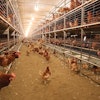The Obama administration’s “new era of federal leadership” to restore the Chesapeake Bay puts the Delmarva poultry industry squarely in the Environmental Protection Agency’s crosshairs.
For readers outside Delmarva, who might think “better them than us,” don’t get too comfortable because federal planners see the program as a model to be rolled out elsewhere.
The Nov. 9 release of the “Draft Strategy for Protecting and Restoring the Chesapeake Bay” set the clock ticking on a 60-day comment period that will lead to the establishment of expanded regulatory authority and new limits for nitrogen, phosphorus and sediment flowing into the bay.
Milestones and consequences
EPA has sent letters to the six bay watershed states (Delaware, Maryland, New York, Pennsylvania, Virginia and West Virginia) detailing what it expects is needed to fulfill the strategy, and the agency has outlined consequences to follow if progress does not meet expectations.
The strategy requires states to set two-year milestones for reaching their pollution goals, and projects that all of the measures needed to restore the bay’s health will be in place by 2025.
If states don’t meet their targets for reducing pollution flowing into the Chesapeake Bay, the EPA plans to punish them. Consequences, EPA officials say, might include rejecting environmental permits issued by the states or cutting off federal money intended to clean up waterways.
TMDL for the Chesapeake Bay
By this month, EPA expects to have established a Total Maximum Daily Load (TMDL) for the Chesapeake Bay. Under the TMDL process, EPA will provide the watershed states and the District of Columbia with draft loading reduction targets for nitrogen and phosphorus for each major river basin in the watershed. By spring of 2010, sediment targets are to be set.
EPA expects the seven jurisdictions to use the draft loading targets to further subdivide and allocate the needed reductions among point and nonpoint sources of nutrient and sediment pollution. Using that information EPA intends to establish waste load and load allocations for those sources in the Bay TMDL.
Significant reductions in nitrogen, phosphorus and sediment are needed to achieve water quality goals throughout the bay and its watershed, says EPA. Last year, an estimated 283 million pounds of nitrogen and 16.3 million pounds of phosphorus reached the bay, according to computer models. Nitrogen and phosphorus loads will have to be reduced by 30% and 8%, respectively, to meet the goals, says the agency.
Political pecking order
States will be under pressure to figure out how to make farms, cities and suburbs cut their pollution. Guess who gets first mention on regulators’ lists of pollution contributors? Yes, agriculture! Following are EPA figures on sources of Chesapeake Bay pollution:
Sources of nitrogen: Municipal and industrial wastewater (19%); Atmospheric deposition – mobile, utilities and industries (19%); Agriculture-Manure (17%); Agriculture – Chemical fertilizer (15%); Developed lands – chemical fertilizer (10%); Atmospheric deposition to tidal waters (7%); Agricultural atmospheric deposition (6%); Septic systems (4%); and Atmospheric deposition – natural (1%).
Sources of phosphorus: Urban/suburban runoff and in-stream sediment (31%); Agriculture – manure (26%); Municipal and industrial wastewater (21%); Agriculture – chemical fertilizer (19%); and Natural sources (3%).
Sources of sediment: Agriculture (60%); Natural sources (21%); and Urban/suburban runoff and in-stream sediment (19%).
Increased coverage, higher standards for CAFOs
EPA also plans to initiate rulemaking to increase coverage and raise standards for CAFOs. The agency says it may not promulgate Chesapeake Bay-specific regulations, if the states and D.C. strengthen their pollution control programs to achieve the reductions in nutrient and sediment pollution needed to meet the bay water quality standards. Either way, get ready, because more regulation and stiffer standards are on the way!
The draft strategy can be accessed at executiveorder.chesapeakebay.net and comments can be submitted through www.regulations.gov. The draft strategy will evolve through public comments, state consultations and agency revisions before the final strategy is published in May 2010.


















